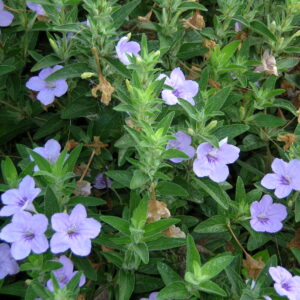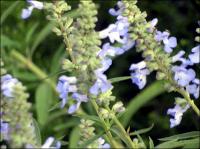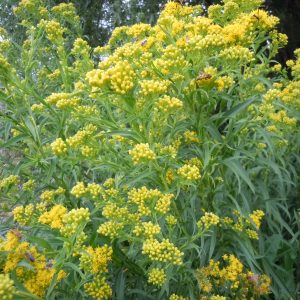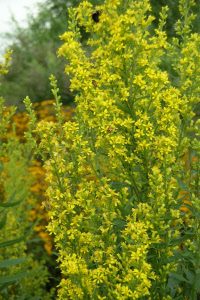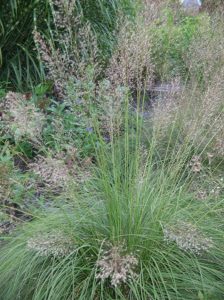Prairie Plants
Showing 73–80 of 85 results
-
Ruellia humilis Prairie petunia Z 3-9
Lilac open-face trumpets late June-October. Slow to emerge in spring so be patient and watch for it. It’s one of those non-flashy work-horses. One of internationally known garden designer Piet Oudolf’s 100 “MUST HAVE” plants, Gardens Illustrated 94 (2013)
Lilac open-face trumpets late June-October. Slow to emerge in spring so be patient and watch for it. It’s one of those non-flashy work-horses. One of internationally known garden designer Piet Oudolf’s 100 “MUST HAVE” plants, Gardens Illustrated 94 (2013)
Size: 10-12” x 10”
Care: sun in any soil
Native: Midwest south to Florida and Texas, Wisconsin endangered plant.
Wildlife Value: Pollinated primarily by long tongue bees who can reach far into the flower’s throat.Ruellia named for French royal herbalist Jean Ruell (1474-1537.) First collected by Thomas Nuttall (1786-1859) C.1810 English plant hunter who found more American plants than anyone else, early 1800’s.
-
Salvia azurea ‘Grandiflora’ Blue sage, Prairie sage Z 5-9
August – October sky blue racemes. One of internationally known garden designer Piet Oudolf’s 100 “MUST HAVE” plants, Gardens Illustrated 94 (2013)
August – October sky blue racemes. One of internationally known garden designer Piet Oudolf’s 100 “MUST HAVE” plants, Gardens Illustrated 94 (2013)
Size: 4’ x 24-36”
Care: Sun, moist well-drained soil
Native: MI to e. NE, s. AR & TX, Wisconsin native
Wildlife Value: Primarily long tongued bees such as Bumble bees visit and pollinate the plants. Host for caterpillars of Hermit Sphinx butterflyNative Americans roast or popped the seed of Blue sage as a grain. American garden cultivation since 1700’s. William Robinson, father of the mixed perennial border, praised the Blue sage as “one of the finest (perennials from North America) in its flowers, borne as dense spikes of a beautiful pale blue during September and October.”
-
Schizachyrium scoparium syn. Andropogon scoparium Little bluestem Z 3-9
Wispy, feather-like seedheads atop blue-grey foliage that turns plum-orange-red in fall.
Wispy, feather-like seedheads atop blue-grey foliage that turns plum-orange-red in fall
Size: 18" x 12"
Care: sun in well-drained soil.
Native: all No. America
Wildlife Value: leaves food for Skipper butterfly caterpillars and seeds food for songbirdsFirst collected by French plant hunter André Michaux in America’s prairies c. 1790. Comanche used it to remedy syphilitic sores. Lakota made soft, wispy seedheads into liners for moccasins.
-
Silphium perfoliatum Cup plant Z 3-9
Golden daisies waive at the sun from July to September, its cup shaped leaves hold water where butterflies drink & bathe
Golden daisies waive at the sun from July to September, its cup shaped leaves hold water where butterflies drink & bathe
Can not ship to: Connecticut and New York
Size: 7’ x 3’
Care: full sun to part shade in moist soil
Native: Central North America, native to Wisconsin.
Awards: England’s Royal Horticultural Society Award of MeritSap used by Native Americans to chew and freshen breath. Also used to cure colds, neuralgia, fever, and liver disorders. The Chippewa used to stop lung hemorrhaging, menstrual bleeding and cure chest pain. The Winnebago drank a potion from the plant to purify themselves before a buffalo hunt. For the Iroquois it cured paralysis, prevented children from seeing ghosts and illness caused by the dead. Lakota Sioux: “Children sometimes use the resin as chewing gum. An infusion of the whole plant is used to rid horses and humans of intestinal worms. An infusion of the leaves is used to loosen phlegm in the lungs. Described and classified in 1753.
-
Solidago caesia syn. Solidago axillaris Blue-stemmed goldenrod, Wreath goldenrod Z 4-9
Graceful, arching wands of clustered gold, with contrasting blue-green stems in September-October. One of the last perennials to bloom. Clump forming, noninvasive perennial.
Graceful, arching wands of clustered gold, with contrasting blue-green stems, in September-October. Clump forming, noninvasive perennial.
Size: 18-24” x 16-20”
Care: part shade to shade in well-drained soil, drought tolerant
Native: Nova Scotia to WI, south to FL and west to TX, Wisconsin native
Wildlife Value: With both nectar and pollen this attracts, bees, wasps and flies. It is host to caterpillars of some moths.The Latin name is a combination of solidus and ago, meaning “I make whole”, referring to its historic medicinal uses. According to William Cullina it has antioxidant, diuretic, astringent and antifungal properties and was used to treat urinary tract and yeast infections, sore throats and diarrhea. (W. Cullina, NEWFS, p. 197) Named by Swedish botanist Linnaeus in 1753.
-
Solidago riddellii syn. Oligoneuron riddellii Riddell’s goldenrod, Stiff goldenrod Z 3-7
Sunshine yellow dome-topped flowers Sept.- Oct. Differs from S. gramnifolia by fewer leaves and its leaves fold toward the center vein.
Sunshine yellow dome-topped flowers Sept.- Oct. Differs from S. gramnifolia by fewer leaves and its leaves fold toward the center vein.
Size: 3’x2’
Care: sun in moist to moist well-drained soil.
Native: swath down middle of No. Am. From Hudson Bay to AK, incl. Wisconsin native
Wildlife Value: Loved by butterflies for its nectar – Small copper, Monarch, Giant swallowtail, Gray hairstreak, Clouded Sulphur, Fritillary, Pearl crescent, & Cloudless sulphur. Attracts praying mantises. Resists deer.The name Solidago from solidus and ago meaning to bring together. First published by German botanist Joseph Frank who named it riddellii in honor of John Riddell who had collected it in Ohio before 1835.
-
Solidago speciosa Showy goldenrod Z 3-8
Broad spikes of erect panicles of mustard yellow welcome late summer into autumn
Broad spikes of erect panicles of mustard yellow welcome late summer into autumn
Size: 3-5’ x 12-18”
Care: Sun, any soil, stands up to wind, no staking needed
Native: Central & eastern US, Wisconsin native
Wildlife Value: Loved by butterflies for its nectar – Small copper, Monarch, Giant swallowtail, Gray hairstreak, Clouded Sulfur, Fritillary, Pearl crescent & Cloudless sulfur. Attracts praying mantises.Meskwaki applied an infusion made of roots to burns. Chippewa used this plant for many things – to stop bleeding in the mouth and lungs, reduce pain from strains and sprains, as a stimulant and tonic and, mixed with bear grease, for a hair ointment. HoChunk and Winnebago made a blood purifier and remedied incontinence. Collected by Thomas Nuttall, English planthunter (1786-1859) who wandered over all of No. America searching for plants, animals, birds and rocks from 1809 to 1842.
-
Sporobolus heterolepsis Prairie dropseed Zone 3 – 9
Mound of graceful thinnest of grass blades
The description in the Chiltern Seeds catalog cannot be improved: “This is the most elegant and refined of the North American prairie grasses …the finest texture composed of the thinnest of thin, thread-like, glossy green blades,.. in autumn turning deep orange before fading to a light copper for the winter. In late summer the plants bear, on very slender stalks high above the foliage, unbelievably delicate, graceful flower panicles, excellent for cutting. ”One of internationally known garden designer Piet Oudolf’s 100 “MUST HAVE” plants, Gardens Illustrated 94 (2013)
Size: 2’ x 2’
Care: Full sun in well-drained soil
Native: from Canada in the north to Texas in the south, Wisconsin native
Wildlife Value: seeds are food for birds
Awards: Missouri Botanic Garden Plant of Merit & Great Plants for Great Plains Grass of the Year.Sporobolos is Greek from sporo meaning seed and ballein meaning to cast forth because the seed readily falls from the flower (or dropseed, the common name). Ojibwa “Medicine Society” used roots to cure sores & “remove bile.”

